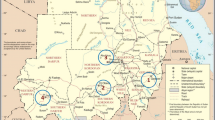Abstract
Genotyping of Kazakh camels Camelus dromedarius (milk breed) (n = 18) and Camelus bactrianus (meat breed) (n = 18) by alpha-S1-casein (αs1-CN) and kappa-casein (κ-CN) loci was conducted using the PCR–RFLP analysis method. A new pair of primers was suggested for the amplification of the CSN3 gene fragment with subsequent cleavage of the reaction products by AluI restriction endonuclease in order to identify the gene genetic variants. DNA polymorphism was detected only for the kappa-casein locus; no genetic polymorphism for alpha-S1-casein gene was found in the studied populations. Analysis of the results of DNA fingerprinting demonstrated that the band sharing (BS) coefficient between the groups was low enough (0.13), and the genetic distance (D) between Dromedary and Bactrian breeds was 0.305. The results of genotyping of Bactrian and Dromedary Kazakh camel breeds by alpha-S1-casein, kappa-casein loci, and DNA fingerprinting indicate that the Dromedary breed female camels are more polymorphic as compared with Bactrian.
Similar content being viewed by others
References
Alim, N., Fondrini, F., Ionizzi, I., Feligini, M., and Enne, G., Characterization of casein fractions from Algerian dromedary (Camelus dromedarius) milk, Pak. J. Nutr., 2005, vol. 4, no. 2, pp. 112–116.
Konuspayeva, G., Faye, B., and Loiseau, G., The composition of camel milk: a meta-analysis of the literature data, J. Food Comp. Anal., 2009, vol. 22, no. 2, pp. 95–101.
Nikkhah, A., Equidae, camel, and yak milks as functional foods: a review, J. Nutr. Food Sci., 2011, vol. 1, no. 5, pp. 100–111.
Kappeler, S., Farah, Z., and Puhan, Z., 5'-Flanking regions of camel milk genes are highly similar to homologue regions of other species and can be divided into two distinct groups, J. Dairy Sci., 2003, vol. 86, no. 2, pp. 498–508.
Al-Haj, O.A. and Al Kanhal, H.A., Compositional, technological and nutritional aspects of dromedary camel milk, Int. Dairy J., 2010, vol. 20, no. 12, pp. 811–821.
Ereifej, K.I., Aludatt, H.M., AlKhalidy, H.A., Ali, I., and Rababah, T., Comparison and characterization of fat and protein composition for camel milk from eight Jordanian locations, Food Chem., 2011, vol. 127, no. 1, pp. 282–289.
Martin, P., Ferranti, P., Leroux, C., and Addeo, F., Non-bovine caseins: quantitative variability and molecular diversity, in Advanced Dairy Chemistry, vol. 1: Proteins, Cox, P.F. and McSweeney, P.L.H., Eds., New York: Kluwer Academic/Plenum Publ., 2003, pp. 277–317.
Pauciullo, A., Shuiep, E.S., Cosenza, G., Ramunno, L., and Erhardt, G., Molecular characterization and genetic variability at κ-casein gene (CSN3) in camels, Gene, 2013, vol. 513, no. 1, pp. 22–30.
Pauciullo, A., Giambra, I.J., Iannuzzi, L., and Erhardt, G., The β-casein in camels: molecular characterization of the CSN2 gene, promoter analysis and genetic variability, Gene, 2014, vol. 547, no. 1, pp. 159–168.
Eltanany, M., Elfaroug, S.O., and Distl, O., Assessment of genetic diversity and differentiation of two major camel ecotypes (Camelus dromedarius) in Sudan using microsatellite markers, Arch. Anim. Breed., 2015, vol. 58, no. 2, pp. 269–275.
Othman, E.O., Nowier, A.M., and El-Denary, M.E., Genetic variations in two casein genes among Maghrabi camels reared in Egypt, Biosci. Biotechnol. Res. Asia, 2016, vol. 13, no. 1, pp. 473–480.
El-Shuiep, T.S., Giambra, I.J., El-Zubeir, I.M., and Erhardt, G., Biochemical and molecular characterization of polymorphisms of alpha-s1-casein in Sudanese camel (Camelus dromedarius) milk, Int. Dairy J., 2013, vol. 28, no. 2, pp. 88–93.
Tahmoorespur, M., Sekhavati, M.H., Kahbiri, A.A., and Mohammadhashem, A., Sequencing and bioinformatics analysis of kappa-casein exon 4 gene in Iranian bacterianus and dromedaries camels, Iran. J. Appl. Anim. Sci., 2016, vol. 6, no. 1, pp. 219–224.
Prasad, S., Ali, S.A., Banerjee, P., Joshi, J., Sharma, U., and Vijh, R.K., Identification of SNPs and their validation in camel (Camelus bactrianus and Camelus dromedarius), J. Agric. Vet. Sci., 2014, vol. 7, no. 2, pp. 65–70.
Tanegonbadi, R., Azari, M.A., Zerehdaran, S., Khanahmadi, A., and Toghdory, A., Study of kappa-casein gene polymorphism association with milk production and composition in Golestan province camels, Genet. Engineer. Biosafety J., 2016, vol. 5, no. 1, pp. 61–66.
Kiselyova, T.Y., Podoba, B.Y., Zabludovskiy, Y.Y., Terletskiy, V.P., Vorobyev, N.I., and Kantanen, J., The analysis of 30 microsatellite markers in local cattle populations, Agric. Biol., 2010, no. 6, pp. 20–25.
Mahrous, K.F., Ramadan, H.A.I., Abdel-Aziem, S.H., Abd-El, MordyM., and Hemdan, D.M., Genetic variations between camel breeds using microsatellite markers and RAPD techniques, J. Appl. Biosci., 2011, vol. 39, pp. 2626–2634.
Mehta, S.C., Goyal, A., and Sahani, M.S., Microsatellite markers for genetic characterisation of Kachchi camel, Indian J. Biotechnol., 2007, vol. 6, pp. 336–339.
Gautam, L., Mehta, S.C., Gahlot, R.S., and Gautam, K., Genetic characterization of Jaisalmeri camel using microsatellite markers, Indian J. Biotechnol., 2004, vol. 3, pp. 457–459.
El-Kholy, A.F., Zayed, M.A., Shehata, M.F., Salem, M.A.I., El-Bahrawy, K.A., El-Halawany, N., and Hassanane, M.S., Association of single nucleotide polymorphisms for myogenic factor 5 and growth hormone genes with meat yield and quality traits in one humped camel (Camelus dromedarius), Asian J. Anim. Vet. Adv., 2016, vol. 11, no. 5, pp. 263–271.
Mohamed, A.E., Babiker, I.A., and Mohamed, T.E., Preparation of fresh soft cheese from dromedary camel milk using acid and heat method, Res. Opin. Anim. Vet. Sci., 2013, vol. 3, no. 9, pp. 289–292.
Muzzachi, S., Oulmouden, A., Cherifi, Y., Yahyaoui, H., Zayed, M.A., Burger, P., Lacalandra, G.M., Faye, B., and Ciani, E., Sequence and polymorphism analysis of the camel (Camelus dromedarius) myostatin gene, Emir. J. Food Agric., 2015, vol. 27, no. 4, pp. 367–373.
Tyshchenko, V.I., Dementieva, N.V., Terletskiy, V.P., and Yakovlev, A.F., Evaluation of genetic variability in chicken populations by genome fingerprinting, Agric. Biol., 2002, no. 6, pp. 43–46.
Author information
Authors and Affiliations
Corresponding author
Additional information
Original Russian Text © M.E. Yelubayeva, B.A. Buralkhiyev, V.I. Tyshchenko, V.P. Terletskiy, Y.S. Ussenbekov, 2018, published in Tsitologiya i Genetika, 2018, Vol. 52, No. 3, pp. 15–24.
About this article
Cite this article
Yelubayeva, M.E., Buralkhiyev, B.A., Tyshchenko, V.I. et al. Results of Camelus dromedarius and Camelus bactrianus Genotyping by Alpha-S1-Casein, Kappa-Casein Loci, and DNA Fingerprinting. Cytol. Genet. 52, 179–185 (2018). https://doi.org/10.3103/S0095452718030040
Received:
Published:
Issue Date:
DOI: https://doi.org/10.3103/S0095452718030040




